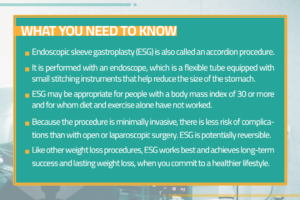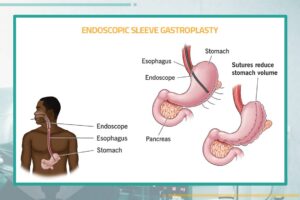Endoscopic Sleeve Gastroplasty
Endoscopic Sleeve Gastroplasty (ESG) can be a less invasive option to laparoscopic sleeve gastrectomy for the appropriate patient. Both techniques shrink the stomach, however the surgical method accomplishes it by excising a portion of the stomach, whilst the endoscopic suture method (ESG) sews the stomach’s folds together like an accordion (think of it like sewing a dart to fit clothes). For most patients, endoscopic sleeve gastroplasty is reversible.
 For Whom Might Endoscopic Sleeve Gastroplasty be Appropriate?
For Whom Might Endoscopic Sleeve Gastroplasty be Appropriate?
Adults who may benefit from endoscopic sleeve gastroplasty include those who:
* Possess a body mass index (BMI) of 30 or over, which indicates obesity;
* Have not been successful in changing their lifestyle to include exercise and diet;
* Are trying to find a substitute for less intrusive bariatric surgery;
Are you ready to dedicate yourself to living a better lifestyle?
ESG can be used in a strategy to lower the risk of diseases including high blood pressure, diabetes, fatty liver disease, sleep apnea, or heart disease that are linked to weight. When paired with a regimen that incorporates exercise, behavioral therapy, and dietary adjustments, this technique is very successful. ESG may not be useful for persons with illnesses including stomach ulcers, big hiatal hernias and bleeding issues.
Endoscopic Weight Loss Surgery
Which medical issues can be helped by the endoscopic sleeve procedure?
The state of obesity is complicated and long-lasting, with a tendency to worsen with time. It’s also linked to a host of harmful health outcomes, including as Type 2 diabetes, liver disease, and cardiovascular disease.
For obese individuals, losing weight may lower their chance of developing certain illnesses. Losing weight can counteract the effects of any ailments you already have and eliminate the need for medication to keep it under control.
While there are many benefits to the treatment, it is important to consider the potential dangers of endoscopic sleeve gastroplasty. It is usually advisable to consider all aspects before coming to a choice.

Benefits of ESG
1. Minimally Invasive Nature: The unique feature of ESG is its minimally invasive technique, which is applied solely through the mouth and does not require any abdominal incisions. Patients who receive this treatment have a much less physical impact, which could result in fewer problems and faster recovery times.
2. Decreased Risk of Problems: Compared to standard weight-loss procedures, ESG has a lower risk of problems, such as infections and hernias, because it employs an endoscopic, suture-based method.
3. Reduced Recovery Time: Compared to traditional operations, patients undergoing ESG frequently heal more quickly, enabling a quicker return to regular activities and job obligations.
4. Effective Weight Loss for Certain People: ESG has demonstrated encouraging outcomes in encouraging weight loss by decreasing stomach capacity, which in some people causes early satiety and a subsequent decrease in weight.
Watch the full procedure of Gastric Balloon
Cons of ESG
- Possible Risks during the Procedure: Although minimally invasive, there are risks associated with the procedure, including as hemorrhage, perforation, or anesthesia-related adverse effects.
- Variable Effectiveness among Different Individuals: The degree to which ESG helps patients lose weight varies depending on a number of factors, including lifestyle and nutritional adjustments made after the treatment.
- The Value of Modifying One’s Lifestyle Post-Procedure: For long-term weight loss and general health gains, successful use of ESG requires considerable lifestyle changes, including as dietary adjustments and consistent exercise.
- With ESG, you can achieve revolutionary weight loss at Natural Beauty Turkey, a center of expertise in Istanbul’s medical community.
Endoscopic Sleeve Gastroplasty vs. Gastric Bypass
In addition to ESG, other surgical techniques that can help patients lose weight by decreasing the size of their stomachs include roux-en-Y gastric bypass and laparoscopic gastric sleeve. A gastric bypass alters the architecture more drastically and necessitates skin incisions, unlike endoscopic sleeve gastroplasty.
By using a gastric bypass, a tiny pouch made of the stomach’s remnants is joined to the small intestine. Food passes through the little pouch without going through the entire stomach. The relationship between the stomach and intestine remains unchanged following sleeve gastroplasty. Reduced discomfort, reduced problems, and a quicker recovery period are possible outcomes of this.
Gastric bypass, a more complex procedure, can result in significant weight loss but also poses risks and side effects like anemia, vitamin deficiencies, and dumping syndrome, which doctors can help patients evaluate.
Recovery Following ESG
At an ESG, most people return home the same day. Some require a minimum of one night’s stay in the hospital for observation. When you are released, you need someone to drive you home.
Diet for Endoscopic Sleeve Gastroplasty
When you recover from ESG and adjust to the lower stomach volume, your doctor will give you specific advice on what foods to eat and what not to consume. During the initial weeks, dietary limitations could involve any of the following.
* First eight hours: just clear beverages and no food.
* The first week: no alcohol or caffeine, liquid diet with protein powder.
* Second week: Include low-sugar and low-fat soft foods (those that mash easily with a fork).
* After a month: You can often begin consuming modest amounts of solid food.
Before and after Mini Lip
After the treatment, will I need to adhere to a certain diet?
Indeed, you will follow a strict diet for the duration of your rehabilitation, which is approximately one month. This will allow your stomach to recover. You’ll receive all the information from your provider. You will begin with a liquid diet and work your way up to soft foods and then solids.
ESG Surgery Cost
The cost of an endoscopic sleeve gastroplasty might change depending on a number of variables. Factors like the medical staff’s experience, the reputation of the hospital, and the facility’s location can all have a big effect on the total cost. Comparatively speaking, ESG is typically less expensive than more conventional weight-loss procedures like gastric bypass or sleeve gastrectomy. However, precise cost estimates vary based on particular circumstances and healthcare providers. In order to compare the expenses of ESG to other weight-loss treatments, prospective patients are advised to examine their options, think about different providers, and speak with their medical professionals.
Does Insurance Cover Endoscopic Sleeve Gastroplasties?
Insurance coverage for endoscopic sleeve gastroplasties (ESGs) varies greatly and is dependent on a number of variables. While some insurance companies may cover ESG, others may not have plans that do. When deciding coverage for ESG, insurance companies typically take into account variables such the policyholder’s particular insurance plan, the degree of obesity, proven failures at trying to lose weight the normal way, and the existence of obesity-related medical disorders.
Endoscopic Sleeve Gastroplasty Complications and Side Effects
• Possible temporary stomachache, nausea, and vomiting.
• Doctors may prescribe medication to alleviate symptoms.
• Minimally invasive operation reduces risk of serious complications.
• Risks include bleeding, infection, stomach tears, abscess, stomach contents leaking into chest or abdominal cavity, pulmonary embolism, pneumoperitoneum, and pneumothorax.
Endoscopic Sleeve Gastroplasty Near Me
Endoscopic sleeve gastroplasty results in weight loss of 12% to 20% within a year. The best results are achieved through an integrated support program, which helps control appetite and establish new eating habits, often paired with behavioral therapy, exercise, and nutritional guidance. You`ll received full treatment packages at Natural Beauty Turkey.






